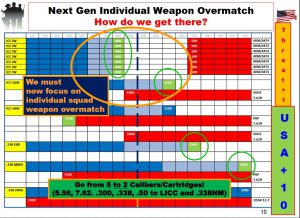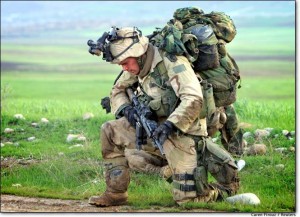
If you’re a “gun guy” you’ve read a flurry of articles on the Army considering fielding a 7.62mm rifle to replace the 5.56mm M4 as an interim step to eventually adopting a new caliber next decade. The driving force is a perceived overmatch by our current and future potential enemies. It’s an effort fraught with errors in logic, understanding how we fight and forgetting history. The only positive is it’s about a new gun and who doesn’t like a new gun? The problem is buying new stuff doesn’t necessarily fix a problem unless you understand the problem. Try fixing your trucks steering alignment problem by buying new bigger tires. Sure the truck looks cooler but you didn’t fix the problem and probably created some you didn’t intend. (Hope you got that lift kit.)
The driving force behind this initiative is a perceived overmatch the enemy has over the average Grunt. The problem is the shortfall relies on an apples and oranges comparison. Anecdotal reports from the field are that snipers equipped with Enfields and Dragunov sniper rifles as well as medium machine guns like the PKM and the PKP are outranging the Grunt’s ability to shoot back. Yes, they do and to someone who doesn’t understand how we arm units (not individuals) or who has never been in a firefight, it would seem to make sense. Contrary to what may at first look seem reasonable, it isn’t how we fight or counter a threat.
We have our own sniper systems, fielded all the way down to squad level as well as our own medium machine guns to counter those enemy systems. Admittedly we do need a new machinegun to match the PKP’s 1500m range but that doesn’t make the case for a new individual rifle. Equipping every grunt with the ability to fight a sniper or crew served machine gun is as logical as equipping every infantryman with an anti-tank weapon because he might have to fight a tank. We don’t fight that way and that type of thinking weighs down our already overburdened Soldiers and Marines.

Slide 10 “A Path to Overmatch Next Generation Individual Weapon System” By Jim Schatz
Here’s another thought, let’s assume despite no actual scientific research (another logic error) that the enemy is effectively engaging us at beyond 300 meters on a consistent and operationally significant basis. For arguments sake let’s say the case is actually better supported than just the anecdotal situations that are the basis of this perceived overmatch. Wouldn’t it behoove us to teach our troops to shoot at greater ranges NOW even before evaluating a new interim rifle on the way to determining an unknown new round? Developing a training program is exponentially simpler than fielding a new weapon system and could squeeze out a couple of hundred yards of effectiveness from existing systems. Heck, it would be a down payment on the required longer-range training program the future desired weapon system would demand.
Our military does a generally poor job of training longer range engagements. Heck, we don’t train to the max effective range of our current assault weapons. A little over 20% of the Army’s individual qualification course is dedicated to shooting at 300 meters (THREE engagements with a 10 second engagement window per). The Marines devote TEN rounds to shooting at a six-foot by six-foot barn door at 500 meters with a full minute to fire each round at that range. Realistic? Adequate? I think not.
Unfortunately, it’s not sexy to improve training instead of getting new kit. The military doesn’t have a “Training Corps” but they do have an “Acquisition Corps”. There’s a profundity there. Also, vendors don’t make much money from training versus selling a product outright. Our military still conducts most of their training in house with uniformed staff. Those troops aren’t siphoning off campaign contributions from a new training initiative. Major weapons sources habitually grease the political skids with cash, another factor that pushes for material solutions to potential training problems.
What about the efficacy and efficiency of switching to a 7.62 rifle just to be able to have a system that can be upgraded to another caliber in a decade? Ignoring the default bottomless pit of money approach, why limit ourselves before this new super caliber is selected? What if there is a better super caliber specific rifle available in the future when this super round is selected versus the interim rifle being proposed today? Do we just start again from scratch from a new bottomless pit of money? Hey, I’m all for giving troops the best tools AND TRAINING to address the threat but maybe we should confirm what the actual threat is, create the training and then select the caliber instead of a step backward to maybe take a step forward?
There exists a train of thought that adopting 7.62 distances us from 5.56 putting us on the right path to getting to a supposed better and larger round. Ignoring that this better round hasn’t been identified yet, this approach ignores the proverbial 800-pound gorilla. That supposed better round is always a bigger round. Why did we leave 7.62? Well it wasn’t just because of McNamara’s overarching influence on the Department of Defense in the 60’s. 7.62mm ammunition and rifles have downsides to being generally issued.
Most of the negative challenges resulting from the selection of a 7.62 battle rifle derive from weight. A slightly heavier rifle is required to fire the round but the real debilitating factor is the weight of the ammunition. 7.62 is almost twice the weight of 5.56 ammo. This is not a small matter especially considering how overburdened the Soldier and Marine is today. The choice then becomes to either add to the combatant’s load or do with less. More weight will slow the troop down further as well as cause him to tire more quickly. This is a cumulative phenomenon. Carrying a heavier load for a day is unpleasant. Carrying it for weeks on end is soul crushing.

Lightening the load by carrying less ammo has even worse second order effects. We rely on fire and maneuver to close with to kill, capture or destroy the enemy. The ability to suppress the enemy is critical to being able to maneuver to a position of advantage against him. Suppression requires ammo. Less ammo means less suppression which means less maneuver. That can result in mission failure as well as more casualties. Less ammo also means more frequent resupply. Solutions to ease supply constraints often require minimizing the distance between the source of supply and the user which makes for slow progress. Another solution is stockpiling supplies on the warfighter, a return to the weight problem.
Weight is a major issue often ignored by fans for fielding an intermediate rifle. A recent counter to the weight conundrum is a belief that polymer or telescoped casing will fix the issue. We’ve been chasing this solution for decades. We should not field an intermediate rifle and pin our hopes on a technology breakthrough. It first needs to be proven. The promise of a lighter round does little to address the increased weight on one’s back especially since adoption of a 7.62 interim rifle would but that weight on a warfighter’s back for at least five years assuming no setbacks with selecting a new round and the weapon to fire it. Fat chance.
Compared to weight a relatively small but hardly if ever mentioned disadvantage to fielding a 7.62 battle rifle is the additional training that will be required to handle the increased recoil. It’s also worth considering the role of women in the Infantry. The growth of women serving was a small part of the reason we moved to a 9mm pistol round in the 80’s. Women’s increased integration is an important criterion cited by law enforcement organizations when adopting a new pistol and was undoubtedly at play as part of the Army’s demand for modularity in the newly adopted Sig 320 pistol. This isn’t the biggest issue but it is one.
There are many reasons we should not take the interim rifle course. The overmatch argument is a flawed apples to oranges comparison. The inevitable and at one time correct comments that 5.56 isn’t effective rely on old experiences and not the Army’s latest and highly effective round, the M855A1. Giving front line troops a bullet launcher with more range while not giving him the training necessary to employ that weapon creates capability on paper alone. Considering that we don’t train to our current weapons’ max ranges today and haven’t for decades should give one pause.
Switching to an interim rifle because it will handle a bigger round than the current platform is capable of seems to be the opposite approach if we haven’t even identified the new round. That study isn’t going to happen until the next decade. Most importantly though, the weight considerations of 7.62 should be a HUGE red flag for those thinking about fielding a 7.62 battle rifle and a STOP sign for those that will have to actually carry it. How can we invest in an interim rifle to host that unspecified round if we don’t even know what the round will be? What if that new round comes with an ideal platform? Do we start over yet again?
Having listed many reasons as to why the interim rifle shouldn’t be the path what is? Immediately improve longer range marksmanship training so we can get the most out of the rifles we have. Keep the M4 and do the ammo study now. Not because of a fictitious overmatch issue but to see what demonstrable advantages a different round may have and identify the requirements for a rifle to shoot it should a new round substantially increase lethality, accuracy or range at no additional weight to the soldier. That means perfecting polymer or telescoped cases to generate a 40% weight savings.
I suspect this article will cause a stir and be deeply dissatisfying to “gun guys’ like myself. It is a very different take on the “Interim Rifle”. Every article out there seems to focus in a glowing manner on the different potential candidates for an interim rifle. A few will even list a disadvantage or two reference the effort but even then, it’s a cursory nod. It seems that with the potential of a relaxed defense budget the Army feels it has money burning a hole in its pocket. It can be predicted with a high degree of certainty that spending for spending’s sake is hardly ever wise.
